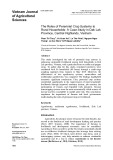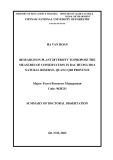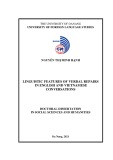MINISTRY OF EDUCATION AND TRAINING
MINISTRY OF HOME AFFAIRS
NATIONAL ACADEMY OF PUBLIC ADMINISTRATION
LÊ VĂN TỪ
STATE MANAGEMENT OF SOCIALISATION OF FOREST PROTECTION AND
DEVELOPMENT IN THE CENTRAL HIGHLANDS OF VIETNAM
Specialty: Public administration management Code: 62 34 82 01
ABSTRACT OF DOCTORAL DISSERTATION IN PUBLIC ADMINISTRATION
HANOI, 2015
This doctoral dissertation is completed at……………………….............................
…………………………………………………………………………...
Supervisors: 1. Assoc. Prof. Dr. Võ Kim Sơn
2. Assoc. Prof. Dr. Nguyễn Bá Ngãi
Offender 1:……………………………………………………………...
…………………………………………………………….....
Offender 2:……………………………………………………………...
…………………………………………………………….....
Offender 3:……………………………………………………………...
…………………………………………………………….....
The oral defense of this PhD. dissertation takes place before the Academy-level Council
Venue: Doctoral Dissertation Defence Room – ….. Floor, ………………. Building,
National Academy of Public Administration
No. 77 - Nguyễn Chí Thanh Str., Đống Đa Dist., Hanoi
Time: ……….. [hour]…….[date]………[month] ……. [year] 2015
This dissertation is available at Vietnam National Library
And at the Library of National Academy of Public Administration
LIST OF SIENTIFIC RESEARCH
1. Lê Văn Từ (2009), State Management of Specialised Use Forests in the Central Highlands, Master
Degree Thesis in Public Administration.
2. Lê Văn Từ (2011), Management of Community Forests in the Central Highlands – Reality and
Solution, State Management Journal, Vol. 11, p. 50.
3. Lê Văn Từ (2013), Participatory Forest Land Allocation during the Socialization of Forestry in the
Central Highlands, State Management Journal, Vol. 9, p. 86.
4. Lê Văn Từ (2013), Reforming Activities of State Forestry Companies for Implementation of
Forestry Socialization in the Central Highlands, State Management Journal, Vol. 11, p. 61.
5. Lê Văn Từ (2014), Challenges to New Public Management in Vietnam, State Management Journal,
Vol. 6, p. 35.
INTRODUCTION
1. Rationale of the Study
Decentralisation and socialization have become an increasingly
indispensable trend in the world.
Socialization is considered a way or tool to support and
promote production.
Vietnam’s forestry has been undergoing great changes of
development strategy from state forestry to socialized one through its
people-based development policies for forest protection and development.
Forest protection and development in the Central Highlands are
being carried out through policies of forest land allocation (FLA),
contracted forest management and protection, forest leasing, attraction of
investment in forest protection and development, and, mobilization and
attraction of participatory forest protection and development. These
policies altogether form a social development process of further
promotion and sharpening of forestry socialization in the Central
Highlands.
The socialization of forest protection and development in the
Central Highlands is experiencing both positive and negative sides or
unidentified trends, especially a lack of close and consistent state
management in the field. As a result, forest land allocation, forest leasing,
and investment in forest business remain odd and inconsistent in terms of
management, methods, and implementation procedures. There haven’t been
clear definitions of forest ownership, use, and mechanisms for benefiting
from forests while the state hasn’t provided timely policy and mechanism
interferences in line with the special context of the Central Highlands.
1
The above-mentioned problems have been limiting the positive
sides of forest socialization, or even further challenging the
implementation while increasing doubts on its feasibility and
effectiveness. There is therefore a need to improve state management of
socialization of forest protection and development in the Central
Highlands, with certain degrees of interference and ways to drive the
forest socialization in the Central Highlands on the right track. That is the
reason why the author has selected the theme of “State Management of
Socialisation of Forest Protection and Development in the Central
Highlands” in hope of contributing to improved effectiveness and
efficiency of forest protection and development, and promotion of the
socialization of forest protection and development in both the Central
Highlands and nationwide.
2. Aims and Tasks of the Study
The dissertation aims to conduct a research on state management of
socialization of forest protection and development in the Central
Highlands both to further enhance and sharpen the theoretical foundation
and to provide scientific recommendations for perfection of state
management of socialization of forest protection and development in the
Central Highlands.
To realize its afore-mentioned aim, the dissertation has the following
tasks of study:
- Systemizing, analyzing, and further clarifying the theories on state
management of socialization of forest protection and development;
- Assessing and analyzing the reality of socialization of forest
protection and development và state management of socialization of
forest protection and development in the Central Highlands;
2
- Providing solutions to perfect state management of socialization of
forest protection and development in the Central Highlands.
3. Objects and Scopes of the Study
The objects of the dissertation include both theoretical and practical
issues of state management of socialization of forest protection and
development in the Central Highlands.
Its scopes are as follows:
- The spatial scope: the Central Highlands of Vietnam;
- The temporal scope: Research data of reality of socialization of
forest protection and development in the Central Highlands between
2001 and 2014;
- The content scope: Socialization of forest protection and
development is in fact a complicated issue both theoretically and
practically. This dissertation therefore focuses mainly on the contents of
state management of socialization of forest protection and development in
the Central Highlands in terms of forest land allocation; financial
investment in forest protection and development; and, development of
community forestry, based on which to provide solutions for state
management of socialization of forest protection and development in the
Central Highlands and effective, sustainable models for forest protection
and development.
4. Methodology
4.1. Approaches
Dialectical materialism and historical materialism form the
foundation for this research.
4.2. Methods of the Study
- Document consulting;
3
- Sociological survey;
- Empirical study.
5. Research question
The dissertation shall answer the question: Will the socialization of
forest protection and development result in sustainable forest
development? If yes, what measures should the state provide accordingly?
Therefore, the hypotheses are as follows:
- The socialization of forest protection and development is an
effective way of forest management and development that contribute to
local inhabitants’ livelihood improvement.
- The closer management and more active measures for socialization
of forest protection and development the state provides, the more effective
sustainable forest protection and development will become;
- The efficiency and effectiveness of state management in
socialization of forest protection and development will be improved through
solutions that perfect state laws and policies, organize implementation of
socialization of forest protection and development, closely monitor and
supervise the process, and, encourage development of community forestry.
- The state plays an extremely important role in orientation,
regulation and support for the process of socialization of forest protection
and development to move in the right direction and achieve its stated goals. 6. New contributions of the study
Theoretically, the dissertation has introduced two new concepts of
socialization of forest protection and development (SFPD), and, state
4
management of socialization of forest protection and development.
Accordingly, it has clearly identified the basic contents of SFPD and state
management of SFPD; and, clearly indicated the roles of state management
of SFPD as well as both rights and duties of the stakeholders. The
dissertation has provided a number of models for sustainable forest
management and protection and plans for rearrangement and reform of
activities of state forestry companies.
Practically, the dissertation’s recommendations form a basis for
perfecting the laws, policies and mechanisms for SFPD towards effective
and sustainable forest protection and development. The dissertation can be
used as a reference for research and lecture by training institutions and
authorities of public administration, forestry and law study.
7. Dissertation Organization
Apart from the introduction, conclusion, and list of references, the
dissertation is structured as follows:
Chapter 1: Overview of research related to the dissertation;
Chapter 2: Scientific background of state management of SFPD;
Chapter 3: The reality of state management of SFPD in the Central
Highlands;
Chapter 4: Perfecting state management of SFPD in the Central Highlands.
CHAPTER 1: OVERVIEW OF RESEARCH RELATED TO
THE DISSERTATION
1.1. Literature review
1.1.1. Research on socialisation
1.1.1.1. Foreign research
1.1.1.2. Domestic research
5
1.1.2. Research on SFPD
1.1.2.1. Foreign research
1.1.2.2. Domestic research
- Research on socialization of forestry;
- Research on forest land allocation;
- Research on community forest management;
- Research on community forest management in the Central
Highlands.
1.1.3. Research on state management of forest protection and
development in Vietnam
- Research on state management of forest protection and
development through law-based state management;
- Research on state management of forest protection and
development through state-administrative management.
1.2. New issues related to the dissertation
- There hasn’t been, before this dissertation, any research on the
theoretical and practical backgrounds of SFPD in the Central Highlands,
except specific studies on a single aspect of socialization.
- There haven’t been, before this dissertation, clear definition of
basic issues related to SFPD (i.e. the rights of forest ownership, use, and
benefit from forests; the role, responsibility, and legal status of the
stakeholders in forest protection and development; and, models for
effective, sustainable forest protection and development in the Central
Highlands).
- Policy making in line with the specific context, culture and
conventions of local people.
6
1.3. Focal issues for the dissertation
- The dissertation shall study to clarify the concepts, comprehension,
principles, forms and scopes of SFPD; issues of ownership, use and benefit
mechanism.
- It shall also clarify the concepts, principles, contents and need of
state management of SFPD, and the state’s role in SFPD: provision of legal
framework, policies and mechanism, support of investment, and co-
management.
- The dissertation shall study the policies on forest land allocation,
benefit from forest, post-FLA support, investment and credit, and joint-
venture; and, analyze and evaluate the results, limitations, causes and
problems facing state management of SFPD in the Central Highlands, so as
to provide solutions for perfecting the SFPD policies and mechanism in line
with the Central Highlands, the competence of state authorities.
- It shall study for perfection of management models for effective
sustainable forest protection and development in the Central Highlands
such as community forestry models, models for forest co-protection.
CHAPTER 2: SCIENTIFIC BACKGROUND FOR STATE
MANAGEMENT OF SOCIALISATION OF FOREST
PROTECTION AND DEVELOPMENT
2.1. Overview of SFPD
2.1.1. Socialisation
2.1.1.1. Concept of socialisation
Socialization can be understood differently according to
different approaches.
7
Socialization is most commonly defined as a process of
outsourcing some of the state’s activities, as well as the process of
organizing, mobilizing, attracting investment and expanding participation
of social stakeholders on the basis of community responsibility to exploit
resources effectively for development of different fields of social life, in line
with the nation’s strategies, planning and laws.
2.1.1.2. Basic principles of socialisation
- It must come from current needs, abilities, and conditions;
- It must ensure a benefit harmony among the stakeholders;
- The stakeholders’ powers and duties are defined in line with their
respective functions, tasks, and characteristics;
- Socialization must ensure the principles of democracy, openness,
and transparency from planning, decision-making, organization of
implementation, to benefit division;
- It must abide by the law;
- It must bring more benefits to people and the community;
- It must ensure stability, adjustability, and suitability;
- Socialization must respect local cultural traditions, beliefs, and
conventions.
2.1.1.3. Forms of socialisation
- The state and other economic sectors both provide public services
and many other areas for society;
- The state orders, raises requirements, and pays non-state subjects
for provision of a service to society and people;
- State authorities cooperating with other subjects provide
services or produce goods to meet demands of society and citizens.
8
2.1.2. SFPD
2.1.2.1. Concept of SFPD
The concept of forest protection and development can be
understood as follows:
Forest protection and development is a combination of activities by
organizations and individuals to influence forests in order to prevent or
cope with negative impacts on forests, so as to maintain and develop
forest eco-systems, creatures, land and other environmental factors;
conserve biological diversity and ecological settings, and, at the same
time, implement forestry techniques to improve forest areas and quality,
bio-diversity, capacity of forest produce, capacity of prevention and other
forest values through fresh forestation, forestation after exploitation,
recovery of forests, and improvement of poor forests.
The concept of SFPD: Socialisation of management of forest
protection and development involves wide participation of different social
subjects such as organizations, communities, households, and individuals
in investment, forest management and protection, forestation, exploitation
and use, and provision of forest-based services, which are previously
carried out by the state, on the basis of community responsibility to bring
about practical effectiveness and benefits for the stakeholders..
2.1.2.2. Forms of SFPD in Vietnam
SFPD is considered in three main aspects: Socialization of
ownership of forest natural resources and land; socialization of
investment in forest protection and development; socialization of
organization of forest protection, production and business.
Vietnam has over the past years experienced two main SFPD
forms:
9
First, the state conducts forest land allocation, and forest and forest
land leasing to organizations, households, individuals, communities and
private businesses so that the latter can conduct direct forest investment,
management, use and business in line with the law.
Secondly, local people and communities engage in contracted
forest management and protection or models for forest co-protection with
the state.
In whatever form, SFPD always require participation of various
forest stakeholders:
- The state, which conducts state management of forest protection
and development;
- Economic sectors owned by the state;
- Private businesses; households and individuals; and,
communities.
Different kinds of forest have different methods of management
and attraction of social participation.
2.1.2.3. Basic contents of SFPD in Vietnam
a) Forest land allocation, forest and forest land leasing to organisations,
households, individuals and communities for the latter’s activities of
forest protection and development
Forest land is allocated to management boards of preventive forests
or specialised use forests; economic organisations; domestic
households and individuals; people’s armed forces; Organisations of
scientific research and technology development; overseas
Vietnamese investing in Vietnam; foreign organizations and
individuals investing in Vietnam that are given forest leasing for
forestation.
10
b) Investment and attraction of investment in activities of forest protection
and development
- Investment in forest protection and development includes state
budget, mobilized sources, and funds for forest protection and
development;
- Investment in forestry must pay special attention to specific
characteristics;
- Policies of investment and investment attraction for forest
protection and development.
c) Community forestry models
Community forestry models involve the following
- Forests and forest lands long managed by communities;
- Forests and forest lands allocated by a local government to
the local community for long-term management and use;
- Activities organized by a community for its benefits.
Community-based forest management models or models for
forest co-protection
- Forests and forest lands managed, used and owned by state
forestry organizations but contracted to a community;
- Forests and forest lands co-protected and co-cultivated by a
number of households and individuals.
2.2. Concepts, principles, contents, and roles of state management of
SFPD
2.2.1. Overview of state management of SFPD
2.2.1.1. State management of socialisation
- The state is the subject of state management and the decision
maker of issues, contents, and policies on mobilization of participation of
11
different economic sectors, social organizations and individuals in
implementation of activities related to different fields.
- The state is a stakeholder in socialization of provision of goods
and services to society and citizens.
The basic contents of state management of socialization
- The state provides a general legal framework based on which
every economic sector, social organization and individual can conduct
activities related to regulated fields.
- The state provides policies to encourage, support, assist and
facilitate stakeholders’ participation.
- The state plays the role of arbitration, inspection, monitoring,
supervision and settlement of violations.
2.2.1.2. Concept of state management of SFPD
State management of SFPD is to state-administrative bodies’
organization of adjustments of SFPD and behaviours of organizations,
individuals and communities in investment and management of forest
protection and development in order to maintain the law and order and to
keep socialisation on the right track toward stated goals.
2.2.2. Principles of state management of SPFD socialization
- Decentralization to the local government;
- Benefit harmony among the stakeholders;
- Equality between ethnic groups;
- Economical, effective use and sustainable development of forests.
2.2.3. Contents of state management of SFPD
- Issuing policies and laws for implementation of SFPD;
- Organizing implementation of SFPD laws and policies;
12
- Monitoring and supervision of implementation of SFPD laws and
policies.
2.2.3.1. Issuing policies and laws for implementation of SFPD
- On forest land allocation, forest leasing;
- On investment and investment attraction;
- On community forestry.
2.2.3.2. Organizing implementation of SFPD laws and policies
Organizing deployment of guiding and supporting forest land
allocation
- The state establishes bodies of state management of forestry to
deploy support to forest land allocation;
- It organizes dispersal of state guidelines, policies, and contents on
forest land allocation; and, provides technical support and forestry
extension;
- It provides and allocates resources for forest land allocation.
Organizing implementation of policies on investment and investment
attraction
- Policies of investment and investment attraction for development of
speciallised use forests;
- Policies of investment and investment attraction for development of
productive forests;
- Organization of deployment of community forestry models.
2.2.3.3. Inspecting, monitoring and supervision of implementation of
SFPD laws and policies
- On forest land allocation, forest leasing;
- On investment and investment attraction;
- On community forestry.
13
2.2.4. The roles of state management of socialization of forest
protection and development
- It ensures SFPD in line with the Party’s guidelines and orientations
and the State’s laws and stated goals.
- Based on its function of management and coordination, the State is
responsible for guiding and facilitating the stakeholders during the process.
- It plays an important role in supporting and encouraging
participation of the stakeholders through favourable policies on land,
investment, loans, taxes, human resource training, etc.
- The State conducts inspection, monitoring, and supervision to
prevent and settle violations during SFPD; it orientates and adjusts those
activities to the right track for effectiveness and stated goals.
2.3. State management of SFPD in the world and lessons for
Vietnamam
2.3.1. Experiences of European countries
2.3.2. Experiences of African countries
2.3.3. Experiences of Asian countries
2.3.4. Lessons for Vietnam
- There must be clear regulations on ownership of and the right to
use forests and forest land to encourage investments in forest protection and
development. Those policies must be facilitating other than prohibiting and
forcing.
- There must be openness and transparency in planning use of forests
and forest land to protect the stakeholders’ benefits; decentralization of
forest management to the local government and community on the basis of
conditional and duty-based rights.
14
- The state must move from forced management to encouragement,
guide and support of citizens; local people are entitled to full participation at
all levels.
- It must create sustainable income and livelihood for local people.
- The state must minimize unnecessary procedures to minimize
costs, time and money of organizations, individuals and businesses during
their participation.
- It must provide mechanisms for close inspection, monitoring and
supervision.
SUMMARY OF CHAPTER 2
The dissertation has clarified the following theoretical issues:
- It has studied state management of SFPD to clarify such basic
concepts as socialization; SFPD; state management of SFPD, and some
related concepts such as forest protection, forest development, forest
protection and development, and community forestry.
- It has clarified basic SFPD principles, based on which to clarify
the basic principle of state management of SFPD;
- The dissertation has clarified the basic contents of SFPD and state management of SFPD: (1) forest land allocation, leasing of forests and
forestry lands, contracted forest management and protection by
organisations, households, individuals and communities; (2) investment and
investment attraction from non-state subjects into forest protection and
development; and, (3) development of community forestry.
The basic contents of state management of forest protection and
development are each analysed in their three major aspects: (1) issuing laws
15
and policies as the legal background for deploying SFPD contents in
practice; (2) organizing implementation of SFPD laws and policies; (3)
inspecting, monitoring, supervising and settling violations during SFPD.
- The dissertation has reviewed experience of forest management in
the world and provided some lessons for Vietnam.
CHAPTER 3: REALITY OF STATE MANAGEMENT OF
SFPD SOCIALISATION IN THE CENTRAL HIGHLANDS
3.1. Overview of forest protection and development in the
Central Highlands
3.1.1. Natural, socio-economic, and cultural conditions affecting forest
protection and development in the Central Highlands
3.1.1.1. Natural conditions
3.1.1.2. Socio-economic conditions
3.1.1.3. Culture and traditions
3.1.2. The reality of forest protection and development in the Central
Highlands
3.1.2.1. Forests and forest land in the Central Highlands
3.1.2.2. Forest protection and development in the Central Highlands
16
3.1.3. Comments
3.2. The reality of SFPD in the Central Highlands
3.2.1. Forest land allocation
3.2.1.1. Achievements
3.2.1.2. Limitations in forest land allocation in the Central Highlands
3.2.1.3. Major causes
3.2.2. Investment and investment attraction
3.2.3. Community forestry
3.2.3.1. Community forest management
3.2.3.2. Community-based forest management
3.3. The reality of state management of SFPD in the Central
Highlands
3.3.1. State management of forest land allocation
3.3.1.1. Issuing legal documents on forest land allocation
- Documents for nation-wide application;
- Documents for application by the Central Highlands.
3.3.1.2. Organization of implementation of forest land allocation
- Establishment of state management bodies for forest land
allocation;
- Assignments of implementation;
- Resources to implement forest land allocation.
3.3.1.3. Inspecting, monitoring, and supervising forest land allocation
3.3.2. State management of investment and investment attraction
trong forest protection and development
3.3.2.1. Issuing legal documents on investment and investment
attraction
17
- Those on investment and investment attraction in forest
protection and development applicable nation-wide;
- Those on investment and investment attraction in forest
protection and development applicable to the Central Highlands.
3.3.2.2. Organising implementation of investment and investment
attraction
3.3.2.3. Inspecting, monitoring, and supervising investment and
investment attraction
3.3.3. State management of community forestry in the Central
Highlands
3.3.3.1. Issuing legal documents on community forestry
3.3.3.2. Supporting and assisting communities in forest management
- Material support;
- Support of knowledge and skills;
- Attraction of non-state investment in forest protection and
development.
3.3.3.3. Controlling and regulating benefits from forests
3.4. Evaluation of state management of SFPD in the Central
Highlands
3.4.1. Achievements
3.4.2. Limitations
3.4.2.1. Those of forest land allocation
3.4.2.2. Those of investment and investment attraction
3.4.2.3. Those of community forestry
3.4.3. Causes
3.4.3.1. Those of forest land allocation
3.4.3.2. Those of investment and investment attraction
18
3.4.3.2. Those of community forestry
SUMMARY OF CHAPTER 3
The dissertation has studied and analysed the practice of state
management of SFPD in the Central Highlands over the past years to find
out the following strengths and weaknesses:
Strengths: The state has issued various guidelines and policies as
background for SFPD deployment applicable both nation-wide and
particularly to the Central Highlands. The policies include those on forest
land allocation, forest leasing, contracted forest management and protection
by households, individuals and communities; encouragement and attraction
of investment in forest protection and development such as policies on
investment, taxation, privileged loans, and other supporting ones. They have
initially attracted non-state investment in forest protection and
development, improved people’s sense of forest protection, and better
protected forests. The activities of inspecting, monitoring, and supervising
have had timely settlement of violations in forest land allocation and
investment projects and provided timely orientation and adjustment of
SFPD activities to keep on the right track and achieve stated goals.
Weaknesses: Investigation, planning and law education have not
been done well before forest land allocation to people; wrong kinds of
forest have been subjectively given to wrong people of forest land
allocation; supporting policies after forest land allocation are unsuitable and
ineffective; authorities lack close and consistent organisation of supervision
of forest land allocation; investments have been imbalancedly structured
while verification of investment projects have been loosely carried out.
There are not enough favourable policies to encourage and attract resources
19
for investment in forest protection and development; the policies for
payment of forest environment services have not been expanded while the
mechanism for collection and payment remain complicated; the legal
foundation and policies for community forestry remain unclear; there are no
effective supporting policies suitable for the conditions, abilities, and culture
of each community that can promote its internal strengths.
The causes largely come from the central government’s policies and
institutions and the local government’s role in state management; the state
has provided neither SFPD policies particularly for the Central Highlands
nor community forestry models for every type of forest and locality, nor
promotion of local ethnic groups’ tradition of sustainable forest
management based on both the laws and conventions.
Forest protection and development in the Central Highlands will
only be successful with active participation from local people and
communities when they are given more power in management,
exploitation, and use of forests as real forest owners and they are entitled to
more benefits from their activities of forest protection and development,
equal to their efforts.
20
CHAPTER 4: PERFECTING STATE MANAGEMENT OF
SOCIALISATION OF FOREST PROTECTION AND
DEVELOPMENT IN THE CENTRAL HIGHLANDS
4.1. The Party’s and State’s orientations for forestry socialisation in
Vietnam and the Central Highlands and issues facing state
management of SFPD in the new context
4.1.1. Change of mindset for forest protection and development
4.1.1.1. Domestic research
4.1.1.2. The Central Highlands
4.1.2. The Party’s and State’s orientations for forestry socialisation
- Attracting economic sectors’ participation in forestry;
- Converting the state forestry into a social one;
- Issuing policies and laws for sustainable forestry development;
- Provinding harmonious benefits between the stakeholders in forest
protection and development.
4.1.3. Issues facing state management of SFPD in the Central
Highlands in the new context
4.1.3.1. Requirements of state management of SFPD in the Central
Highlands
- Forest protection and development must be closely linked to
guarantee of good environment and people’s livelihood;
- People’s and communities’ self-control must be promoted in line
with their traditions and conventions;
21
- Policies particularly suitable with the economic, social and
cultural conditions of the Central Highlands must be issued.
4.1.3.2. State management of SFPD in the new context
4.2. Solutions for enhancing state management of SFPD in the
Central Highlands
4.2.1. Perfecting legal documents to promote SFPD in the Central
Highlands
4.2.1.1. Planning, providing plans for management and use of forests and
forestry land, providing criteria and standards for every type of forest
4.2.1.2. Perfecting legal documents on forest land allocation, leasing of
forests and forestry land, contracted forest management and protection
4.2.1.3. Providing specific stipulations on exploiting, using and benefiting
from forests
4.2.1.4. Providing policies on finance, investment, loans, taxation,
training, forestry extension
4.2.1.5. Perfecting legal documents on joint-venture and cooperation in
forest protection and development
4.2.1.6. Perfecting legal documents on community forestry development
4.2.2. Perfecting organization and operation of state management
of SFPD in the Central Highlands
4.2.2.1. Perfecting the organization and machinery of state authorities to
ensure implementation of SFPD in the Central Highlands
4.2.2.2. Supporting, encouraging, and facilitating SFPD in the
Central Highlands
- Providing sufficient fund for deployment of forest land
allocation, forest leasing, and support, monitoring and supervision after
forest land allocation;
22
- Paying attention to investment in infrastructure, especially roads
in focal areas of material;
- Deploying further solutions to attract investments within and out
of the Central Highlands cho forest protection and development;
- Providing open and transparent information of land availability
for people’s easy, equal, and timely access before forest land allocation;
- Promoting information and market forecast;
- Promoting technical support of forest protection, forestation,
models of combined agriculture and forestry, and technical transference;
- Implementing public administration reforms related to procedures
of exploiting wood for house-building and investment return, transporting
and selling woods;
- The provinces in the Central Highlands must have inter-
provincial and inter-agency cooperation in provision of forestry
development strategies.
4.2.3. Enhancing inspection, monitoring, and supervision of SFPD
in the Central Highlands
- Conducting close inspection and control of converting forestry
land into other purposes;
- Enhancing measures of inspection, monitoring, and
supervision;
- Directing and implementing inspection and monitoring
obedience to the law on forest land allocation and forest leasing;
- Providing coordinative mechanisms between departments of
People’s Committees of different levels in management and supervision
of forestation projects.
23
4.3. Perfecting SFPD models in the Central Highlands
4.3.1. Reforming organization and operation of state forestry
companies in the Central Highlands
4.3.1.1. Reforming the model of forestry companies Type 1
4.3.1.2. Reforming the model of forestry companies Type 2
4.3.1.3. Reforming the model of forestry companies Type 3
4.3.1.4. Reforming the model of forestry companies Type 4
4.3.2. Community forest management models
4.3.2.1. Establishing organisations of community forest management
4.3.2.2. Regulations of operation of the Management Council of
Community Forest and the stakeholders
- Regulations of operation of the Management Council of
Community Forest;
- Conventions for community forest protection and development;
- Regulations on fund management and use, and beneficiary
mechanism;
- Regulations on coordination between the stakeholders.
4.3.2.3. Perfecting methods of forest land allocation to forest management
communities
4.3.2.4. Planning community forest management
4.3.2.5. External support solutions for community forest management
- Legal and institutional support;
- Technical support;
- Financial support.
4.3.3. Models for forest co-protection
4.3.3.1. Components of organisation in models for forest co-protection
4.3.3.2. Operative mechanisms for models for forest co-protection
24
- Provinding contracted forest management and protection to village
communities;
- Supporting with seedlings for productive forestation;
- Joint-forestation;
- Supporting with models for improved livelihood;
- Planning forest co-management;
- Providing regulations on organisation and operation of
management councils;
- Providing regulations on community forest co-management.
4.3.3.2. Stakeholders’ rights and duties
- Duties of the stakeholders (forestry companies, forest
management boards, commune governments, village communities;
- The stakeholders’ rights.
4.3.3.2. Ooperative mechanisms for models for forest co-protection
SUMMARY OF CHAPTER 4
Generally, because states do not have sufficient resources to meet
society’s demands of services, they have to attract non-state subjects to co-
delivery in order to increase community responsibility and effectiveness in
production and service delivery.
The Party’s and State’s direction of forestry socialization
encourages and attract different economic sectors to forest protection
and development; provide sustainable development and harmonious
benefits among participants of forest protection and development;
encourage and facilitate development of joint-venture models in forest
25
protection and development; and, encourage development of community
forestry.
The dissertation has provided three groups of solutions for enhancing
activities of state management of SFPD as follows:
- Perfecting laws and policies to promote SFPD in the Central
Highlands;
- Perfecting organisation and operation of state management of
SFPD in the Central Highlands;
- Enhancing inspection, monitoring, and supervision of SFPD in the
Central Highlands in terms of forest land allocation, investment and
investment attraction, development of community forestry models.
- Perfecting SFPD models: Reforming organisation and operation
of state forestry companies in the Central Highlands; models for community
forest management; models for forest co-protection.
CONCLUSION
Theoretical achievements
SFPD is considered a method or a tool to support sustainable
and effective forestry development. During this process, people and
communities are both objects and direct subjects of forest protection
and development.
SFPD is looked at from three main perspectives being
socialization of ownership of forests and forest land; socialization of
investment in forest protection and development; and, socialization of
organization of forest-based production and business through policies
on forest land allocation, forest leasing, contracted forest management
26
and protection; investment and investment attraction in forest
protection and development; and, development of community forestry.
The state plays an important role in provision of a legal framework
and policies that encourage and support SFPD, attract participation of every
social subject in forest protection and development; organization of
implementation, regulation, supervision of and leading SFPD towards its
stated goals.
An issue facing the state in state management of SFPD is to
define well rights and duties of the stakeholders, ownership, the right to
use and benefit from forests. The state must provide a mechanism for
those subjects to realise the rights in practice.
Practical achievements
- Strengths: the state’s making and issuing of laws and policies
on SFPD applicable nationwide and to the Central Highlands in
particular such as forest land allocation, investment attraction, and
development of community forestry have provided the premise for
participation of organisations, private investors, international
organisations, and especially local people and communities in forest
protection and development.
- Weaknesses: Detailed and timely written instructions are still
absent; people remain given wrong types of forest; forest allocation
has not go hand in hand with forestry land allocation; there are still a
lack of supporting policies after forest allocation related to
investment, loans, taxation, use and benefiting from forests; a legal
framework for community forestry remains absent.
Solutions
27
- Perfecting the system of legal documents to promote SFPD in
the Central Highlands in terms of forest land allocation to households,
individuals and communities; exploitation and use of forest
resources; benefiting from forests; supporting and favourable
policies for forest investment, protection, and business.
- Perfecting organisation and operation of state management of
SFPD in the Central Highlands in terms of perfecting the
organisation and machinery of state management bodies of forest
protection and development; and, planning and plan-making.
- Enhancing inspection, monitoring, and supervision of SFPD.
- Reforming forestry companies.
- Providing models of sustainable forest management./.




































